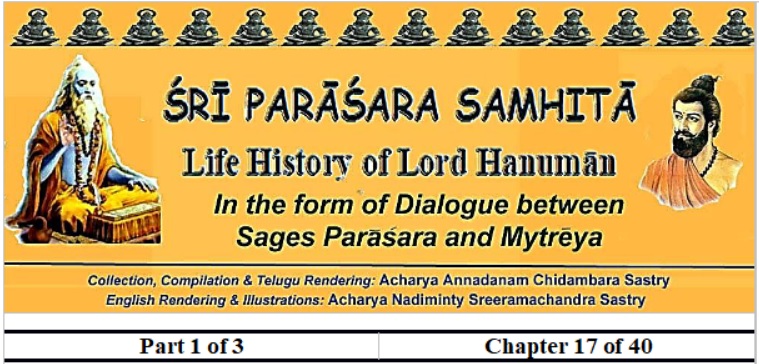
17th Chapter (SaptadaśaPaţalah)
“Description of the Body Touching and Hand Gestures”
(Nyāsamudrāvilaksaņakathanamm)
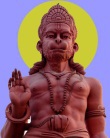
श्रीमैत्रये :
समस्तागमजालानि श्रुतानि सविशेषत:
पुनर्विशेषं पृच्छामि स्वामिन्मे वद मारुते:।। 1
Mytrēya:
“Oh! Lord! Sage Parāśara! I heard from you the details of all the worship related issues along with their special virtues. I am requesting you to enlighten me on more aspects of Hanumān. Please tell me. (1)
स्नानं संध्या जपो होम: मुद्रा वरणदेवता:
अंगमंत्रा न्यासविधि: प्राणायामश्च तर्पणम्
पीठपूजां हनुमतो मे वदस्व महामुने।। 2
Oh! Great sage! Please let me know the procedures for taking ritualistic bath (snanāvidhāna), recitation (japa), fire ritual (hōma), gesticulations (mudras), premises-ruler-gods (āvaraņadēvatas), body part mantras (añgamantas), body touching and hand posturing (nyāsavidhāna), controlled breathing (prāņayāma), libation of water (tarpaņa), worship of the seat of Hanumān (Hanumatpeeţhapooja)”. (2)
श्रीपराशर:
ब्राह्मो मुहूर्ते चोत्थाय शुचिर्भूत्वा सितांबुजे
अनन्तदले संदीप्ते कर्णिकामध्यमे शुभे।। 3
Parāśara:
(Always perform under the guidance of a Guru)
Post-Waking up Activities
“Waking up about one and half hours before dawn (brahmamuhūrte), after morning ablutions, having become clean and pure, contemplate the central round (pericarp) part of a lotus radiant with innumerable petals, (3)
ध्यायेन्मूर्घ्निसितांभोजे सहस्रदलसंयुते
सर्वान्तर्यामिनं देवं भगवंतं सनातनम्।। 4
Imagining the head (top) portion of the white lotus with a thousand petals as that all-pervading, ever present God Almighty. (4)
प्रातश्शिरसि शुक्लाब्जे दिनेशं द्विभुजं गुरुम्
वराभयकरं शांतं स्मरेत्तं नामपूर्वकम्।। 5
In the morning, contemplating that best of gods, Hanumān in the head (top) portion of the white lotus with a thousand petals with two eyes and the two shoulders, the ‘giver’ (varada) and the ‘protector’ (abhaya) aspects; always taking His name in your thoughts. (5)
गुरुं वा भेदबुद्धिर्वैध्यायेत्तन्मध्यमे सुधी:
सिंहासने पुरोदेशे संस्थाप्य गुरुदैवतम्।। 6
The wise one should contemplate a throne in the front portion of it (white lotus) and, with a balanced mind, seat (in imagination) the Guru on it. (6)
गुकारं गुरवे दद्याद्गणनाथाय गं वदेत्
क्षं वदेत् क्षेत्रपालाय सरस्वत्यै च सं वदेत्।। 7
Letter ‘Pa’ for paramātma (the Supreme Being), letter ‘Gu’ for the Guru, letter ‘Ga’ for Gaņanātha (Elephant headed God Ganeş), letter ‘kşa’ for kşetrapālas (ruler deities of the region), letter ‘sa’ for Saraswati (Goddess of Learning), (7)
पकारं च तत: कुर्यात् परमात्मन इत्यपि
नमस्कुर्याद्गुरुं मूर्घ्नि गणेशं दक्षिणे भुजे।। 8
Letter ‘Pa’ has to be uttered for Paramātma (the Supreme Being). Contemplating (imagining) on the Guru in the head (top) portion, Ganēş in the left shoulder (portion), (8)
बामेभुजे क्षेत्रपालं दक्षिणांसे सरस्वतीम्
वामासं परमात्मानं क्रमेण विधिना मुने! 9
Oh! Sage Mytrēya! (also) contemplating serially kşetrapāla in the left shoulder (portion), Saraswati in the right shoulder (portion), again Paramātma in the left shoulder (portion) in proper order, (9)
गन्धपुष्पैश्च धूपैश्च दीपेनामिततेजसा
नैवेद्येनच संपूज्य नमस्कुर्याद्यथाविधि।। 10
Worshipping with sandal paste, flowers, holy fragrance (dhoopam), bright lamps (deepam) and offering of food (neivēdyam), one has to bow reverentially. (10)
आदाय स्नानसामग्र्रीं नदीमभिवसेत्तत:
यथाविधि तत: स्नायात् स्मार्ताचारानुसारत:।। 11
Procedure of taking Bath
Picking up the items needed for bath, proceed to the river, perform bath as stipulated with recitation in the smŗti (scriptures) tradition. (11)
मंत्रस्नानं तत: कुर्यात् एवं तद्विधिरुच्यते
हस्तेन फेनं निष्कास्य आत्मन: पूर्वभागत:
वर्तुलं कवचेना थ विलिखेत्तत्र संयुत:।। 12
Then the mantrasnān (ritual bath) is performed, the procedure of which is described as – taking the pure water, without air bubbles, in hand and, starting from one’s front side, writing (imaginary!) a circular protective ring around, the Hanumatkavaca. (12)
विलिखेदष्टकोणं च चक्रंतत्र प्रयत्नत:
मन्त्रराजस्य वर्णाश्च अष्टकोणेषु विन्यसेत्।। 13
Then, very purposefully, draw a octagon and write a letter each of the Hanumān’s 8-letter mantra (aşţakşrī) in each of the eight angles of the octagon. (13)
अष्टाक्षरीं त्रिरुच्चार्यं अष्टमुद्रा: प्रदर्शतेत्
तदीयमुद्रकं तत्र भावयेदमृतात्मना।। 14
Then the Hanumān’s 8-letter mantra (aşţakşrī) has to be recited thrice and then the eight hand gestures (mudras) be exhibited. Here the sanctified water has to be considered as equal to the divine nectar anŗta). (14)
तत्र दिव्यानि तीर्थानि अंकुशेना हरन्मुने!
सूर्यमण्डलमध्यस्थं हनूमंतं प्रयत्नत:
प्रसन्नमुद्रया तत्र चक्रे संस्थापयेद्बुध:।। 15
Oh! Sage Maitrēya! Considering with the ‘elephant goad’ (ankuśa) mudra (hand sign or seal or mark) athe water to be equal to thart of all the holy rivers, with the ‘pleasant’ (prasanna) mudra Lord Hanumān in the midst of Sun path, has to be set up in the middle of the above imaginary circle. (15)
प्राणायामं तत: कृत्वा तत: स्नानंविधीयते
तत्पादोपरि मूर्धानं त्रिवारं प्रापयेज्जले
जपेदष्टाक्षरीं तत्र मन्त्रराजं त्रिवारकम्।। 16
Prescribed then are the prāņāyāma (controlled breathing) followed by the bath. Feeling that your head is at the feet of Lord Hanumān set up in the middle of the above imaginary circle, take three full dips in the water. Then best amongst all the mantras, the Hanumān’s 8-letter mantra (aşţakşrī) has to be recited thrice. (16)
मुखादिसर्वगात्रेषु प्रोक्षयेत्कुम्भमुद्रया
त्रिवारमष्टवारं वा मन्त्रराजमुदाहरेत्।। 17
Starting from face all the body parts have to be sprinkled (prōkşaņa) with water with ‘pot’ (kumbha) mudra and then, the king of mantras, the 8-letter mantra (aşţakşrī) has to be recited thrice or eight times. (17)
संहारमुद्रया देवं स्थापयेत्पूर्वमण्डले
ततस्तीरं समासाद्य धारयेद्धौतयुग्मकम्।। 18
Then establish (imaginary) the Hanumān form in the earlier mentioned area (mandala). Afterwards come back on to the bank and wear a pair of two white clothes. (18)
मन्त्रस्नानविधानो यं सकलागमसम्मत:
स्मार्तसध्यां तत:कुर्यात् मंत्रसंध्यां पुनस्तत:।। 19
This is the method of ritual bath (mantra snāna) approved by all scriptures on worship (āgama śāstra). (19)
पूर्ववद्विलिखेच्चक्रं प्राणायामं च मूलत:
तच्चक्रमध्ये हनुमत्पादपद्मोदकं त्रिभि:
आचम्य मूलमंत्रेण स्पृशेदंगानि मूलत:।। 20
Again write the circle in the same manner and perform controlled breathing (prāņāyāma). Perform thrice-sipping (ācamana), of the water at the lotus feet of Lord Hanumān in the middle of the above mentioned circle, reciting the base/root mantra (learn from a Guru) go on touching body parts. (20)
त्रिवारमष्टवारं वा मार्जनं मस्तकादित:
मूलेन सकलांगानि पुरराचम्य मूलत:
मनुना मंत्रगायत्रया दद्यादघ्र्यत्रयं तत:।। 21
Rubbing the head clean (mārjana) three or eight times, touching all the body parts while reciting the base/root mantra, also with which perform thrice-sipping of water (ācamana) and then offer water (arghyam) thrice, reciting the Gāyatrī mantra. (21)
आत्मप्रदक्षिणं कुर्यात् मूलमन्त्रेण यत्नत:
मूलेन पुनराचम्य प्राणायामं चरेत्पुन:।। 22
Perform purposeful clock wise self-rotation (ātmapradakşiņa) reciting the base/root mantra. Again perform thrice-sipping of water (ācamana) reciting the base/root mantra and then perform controlled breathing (prāņayām). (22)
मूलमन्त्रं च गायत्रीं यथाशक्ति जपेत्सुधी:
प्राणायामं पुन: कुर्यात् आचम्य विधिवत्पुन:।। 23
A wise person should always recite Hanumān base/root mantra and Gāyatrī mantra as much as one can. Then perform thrice water-sipping (ācamana) and controlled breathing (prāņayām). (23)
संहारमुद्रया चक्रे स्थितंवेदं ह्र्दिन्यसेत्।। 24
Then the picture of the Lord set up in the middle of the circle earlier with samhāra mudra (strike gesture), should be established (taken into) in one’s heart. (24)
नित्यमन्त्रजपं वक्ष्ये श्रृणुष्व मुनिपुड्गवः
मूलेन पुनराचम्य प्राणायामत्रयं पुन:।। 25
Routine Daily Recitation
Oh! Best among the sages! Mytrēya! I am now explaining the daily recitation mantra. Listen. Perform again the thrice-water-sipping (ācamana) followed by controlled breathing (prāņayām) thrice. (25)
विरेच्य दक्षिणेनासा त्रिवारं मूलमन्त्रत:
नासारंधे्रण वामेन द्वादशावृत्तिमात्रत: ।। 26
With the Hanumān base/root mantra inhale (rēcaka) thrice longer through the right nostril. Then exhale (pooraka) six times longer through the left nostril. (26)
षड्वारं रेचयेत्तत्र पुनर्दक्षिणभागत:
एवं हनुमतो मंत्रप्राणायामस्य लक्षणम्।। 27
Then hold breathing (kumbhaka) for the times equal to 12 repetitions of the recitation of the base/root mantra. Then inhale (rēcaka) six times longer through the right nostril. This is the typical feature of controlled breathing (prāņayām) for Hanumān. (27)
भूशूंद्धिंभूतशुद्धिंच न्यासान्कुर्यात् प्रयत्नत:
क्रमेणवक्ष्ये मौनींद्र! समाहितमनाश्श्रृणु।। 28
Oh! Best among the sages! I will now explain the method of purification of Earth (Bhoośuddhi), purification of Undesirable Spirits (Bhootaśuddhi) and nyāsa (systemic body part touching and mudras (hand gestures). I will narrate them in order. Listen with attention. (28)
भूशुद्धिमादौ वक्ष्यामि श्रूयतां मुनि पुड्गवः!
पृथिव्या इत्युदीर्यादौ मेरुपृष्ठऋषिस्तथा।। 29
Bhoośuddhi
Oh! Sage! I will first tell you about Bhoośuddhi. Say first ‘for the Earth’ (pŗthivyā), then say ‘Back (top) of Mount Meru, the Sage’ (Mērupŗşţhaŗşi), (29)
सुतलं छन्दइत्येवं कूर्मो दैवमुच्यते
आसने विनियोगे पि एवं किंचिदथो न्यसेत्।। 30
‘Deep and resolute’ (sutalamchandah), then ‘the Toroise Lord’ (kūrmōdēvatā), and then, keeping the palm on the earth, say ‘accept the seat (āsanēviniyōgah). (30)
ततो नन्तासनायेति नमो न्तं समुदीरयेत्
कमलासनशब्दं च चतुथ्र्यंतं नमो न्तकम्।। 31
Then say ‘I bow to the eternal seat’ (anantāsanāyanamah). (Also) say ‘I bow to the lotus seat’ (kalāsanāyanamah), (31)
विमलासनशब्दं च चतुथ्र्यंतं नमो न्तकम्।। 32
And say ‘I bow to the pure bright seat’ (vimalāsanāyanamah). (32)
पृथ्वी! त्वया धृता लोका देवि! त्वं विष्णुनाधृता
त्वं च धारय मां देवि! पवित्रं कुरु चासनम्! 33
‘Oh! Goddess Earth (bhoodēvī)! You are bearing all the worlds. Vişūu is bearing you. Kindly bear me too. Oh! Goddess (dēvī)! Make the seat holy for me’; so praying the Earth, (33)
अपसर्पंतु ये भूता ये भूता भूविसंस्थिता:।
ये भूता विघ्रकर्तारस्ते नश्यन्तु शिवाज्ञया।। 34
‘Move away! Every dangerous living creature of this place’, I pray, ‘By the command of Lord Śiva, let all the obstacle creating creatures get decimated’. (34)
त्रिवारं घातयेद्भूमावासनेवामपा ष्र्णिना
तालत्रयं प्रकुर्वीत कराभ्यां मूलमन्त्रत:।। 35
(Then) beat down on the (chosen) place of seat thrice with the left heel. While reciting the base/root mantra, clap the of hands thrice to produce sound. (35)
मूलमन्त्रेण दिग्बंधं कुर्यात्प्रकारमात्मन:
एवंप्रकारा भूशुद्धि: यथाशास्त्रमुदाह्रता 36
With a controlled mind, reciting the base/root mantra, make the (imaginary) protective ring from all directions (digbandhah). This protective ring (prākāra; Note: It is Śrīkāra in the original) has to be made reciting the base/root mantra and fire-seed (agnibeeja). So described is the bhoosuddhi in the scriptures. (36)
ब्रह्महत्याशिरस्कं च स्वर्णस्तेयभुजद्वयम्
सुरापानह्रदायुक्तं गुरुतल्पकटिद्वयम्।। 37
Bhootaśuddhi (Purification of Undesirable Spirits)
One who kills a Brāhminperson, one who stole gold, one who drank liquor, one who has hip that coveted Guru’s wife, (37)
तत्संयोगपदद्वंद्वमंगप्रत्यंगपातकम्
उपपातकरोमांण रक्तविश्रुतलोचनम्।। 38
One who keeps friendship with the above four big sinners, one whose every body part is sinful, one who has erect hair due to moderate sins, one with blood-shot (raktaviśruta; Note: Also used is raktarmaśru= blood teared) eyes, (38)
अचैतन्यमधोवक्त्रं दग्धपादपसन्निभम्
अंगुष्ठमांत्रपुरुषं दुरात्मानं दुरासदम्।। 39
One who is unconscious, one who keeps head bent down, one who is life-less like a burnt tree, one who is short like a thumb (anguşţhapramāņa), an evil person, one who is unfit to be close (Note: Also used is durāsśa = greedy), (39)
खड्गचर्मधरं कृष्णं कुक्षौ वामे विचिन्तयेत्
एवं विंचिंत्य पाप्मानं वामकुक्षौ प्रयत्नत:।। 40
One who carries a sword, wears leather, is dark, is a purposeful sinner has to be imagined to be in the left part of your belly, (especially) the purposeful sinner, (40)
तस्यांगं सर्वत:स्थाप्य तज्जीवं मूर्घ्नि विन्यसेत्
तस्यैवांगं प्रयत्नेन वायुबीजेन शोषयेत्।। 41
Setting up (sthāpyā; Note: Also used is puratah= in front) his body parts, his head part has to be imagined to be live. Then his body parts have to be dried off purposefully using the seed mantra of Wind God. (41)
तत: पावकबीजेन तमेव प्रदहेत्पुन:
ततो मारुतबीजेन भस्मीभूतं विसर्जयेत्।। 42
Then the same have to be burnt using the seed mantra of Fire God. Then blow away the burnt residue using the seed mantra of Wind God. (42)
दिव्यमंगलरूपांगं मनसा कल्पयेत्पुन:
देवं मूर्घ्नि स्थितं तत्र प्रविश्या मृतबीजत:
प्राणप्रतिष्ठामन्त्रेण प्राणांस्तत्रोपकल्पयेत्।। 43
Again imagining that grand auspicious form (divyamañgaļrūpa = Hanumān) establish Him at the top of the head (brahmarandhra) using the amŗta seed (amŗtabeeja) mantra and create life in Him using the life-establishing seed (prāņapratişţhabeeja mantra). (43)
ह्र्दये न्यस्तपाणिस्सन् तदेकाग्रमहामना:
प्राणप्रतिष्ठामंत्रं च त्रिवारं समुदीरयेत्।। 44
Keeping the palm on the heart region of chest, with utmost concentration, the life – establishing (prāņapratişţha) mantra has to be recited thrice. (44)
वायुबीजा ग्निबीजेन दक्षिणेन प्रपूरयेत्
प्राणान् संरुघ्य विधिवत् वामेनैव विसर्जयेत्।। 45
Taking a deep breath in through the right nostril reciting the manmtras of the Gods of Wind and Fire, holding it still, leave it through the left nostril in an appropriate (slow) manner. (45)
व। अस्य श्री अन्तर्मातृकासरस्वतीमहामन्त्रस्य। ब्रह्मा
ऋषि:।। गायत्री छन्द: अंतर्मातृका सरस्वती देवता। हल:
बीजानि। स्वराश्शक्तय: बिंदव: कीलकम्। मम अन्तर्मातृका
प्रसादसिद्धर्थे जपे विनियोग:।।
ध्यानम-्
बंधूकाभां त्रिनेत्रां पृथुतरविलसच्छुक्तिमद्रक्तवस्त्राम्
पीनोत्तुड्प्रवृद्धस्तनजघनभरां यौवनारम्भरूढाम्
सर्वालड्कारयुक्त्ं सरसिजनिलयामिन्दुसंक्रान्तमूर्तिम्
अम्बां, पाशाकशड्यां अभयवरकरामंबिकां तां नमामि।। 46
अस्यश्रीअन्तर्मातृका…….
The most gracious, inside mother goddess (antarmātŗkā), great Saraswati mantra, its sage is the Creator Brahma, meter (chandas) is Gāyatrī, inside mother goddess is Saraswati, the seed is the plough (halah), the tones are energies, the key (kīlakamm) is the dot (bindavah), for achieving the benevolence of my inside mother goddess, this recitation is performed (japēviniyogah).
Dhyānam (Meditation):
I bow to – the one bright like the blossoms of bandhuka (Indian Scarlet Mallow; Pentapetesphoenicia), three-eyed goddess, wearing red cloths shining like a pearl shell, one with sturdy bosom and hip region, with apparent manifestation of child bearing age, decorated with all ornaments, having the lotus as abode, form fine like gifted by Moon, resplendent carrying a noose and elephant goad as weapons, with great kind hand showing protection (abhaya) gesture, the motherly form. (46)
अथांतर्मातृकान्यास: कण्ठह्र्न्निभिगुह्राके
पायौ भ्रूमध्यगे वक्त्रे षोडशद्वादशान्विते
दशपत्रे च षट्पत्रे चतुष्पत्रे द्विपत्रके।। 47
Nyāsa – Body Touching and Hand Gestures:
NOTE: Nyāsa means placing and refers to a large component of tantrik (occult) ritualism, in which the practitioner touches various parts of the body at the same time pronouncing a mantra and visualising adēvata (god – goddess) or a root/base (bīja) mantra. Nyāsa is said to “divinise” the body of the worshipper. This is considered to be invoking presence of the deity, of the mantra, inside the body.
Now being explained are the body-touching and hand-gestures to the in-dwelling mother goddess. (Touching the specified parts with right palm) On the throat, heart, navel, secret parts or genitals, between buttocks (wash palm after this), between the eye brows, on the face, on the şōdaśāra (sixteen parts-petals of the visualized lotus-amulet yatra), on the dwādaśāra (twelve parts-petals of the visualized lotus-amulet = yatra), on the ten petal lotus-amulet (daśapatra kamala), on the six petal lotus-amulet (şatpatra kamala), on the four petal lotus-amulet (catuşpatra kamala) on the two petal lotus-amulet (dwipatra kamala), (47)
आधारे लिंग नाभौ, हृयसरसिजे, तालुमूले, ललाटे
द्वौपत्रे षोडशारे, द्विदश, दशदले, द्वादशार्धे, चतुष्के,
नासांते, तालुमध्ये, ढ फ क ट सहिते कण्ठमूले स्वराणाम्
हं क्षं तत्वार्थयुक्तं सकलमुनिनुतं वर्णरूपं नमामि।। 48
On the mooladhāra (base disk as per yogavidya), on the male organ (lińga), on the navel (nābhi), on the heart-lotus (hŗdayakamala), on the base of the palate (tālumoolē), on the forehead, on the şōdaśāra lotus – amulet, dwādaśāra lotus-amulet that is inclusive of the two and ten petals, in the four corners (catuşkōņa), on the tip of the nose, on the middle of the palate (tālumadhyē), on the base of the throat with (uttering!) da phakaţa, self-shining voice-tones with the tatvārdha (philosophical) meaning of hakşa characters, approved by all the sages, I am bowing to such group of letter forms. (48)
व।। अस्य श्री बहिर्मातृकामन्त्रस्य ………..
अन्तर्मातृकावत्।।
ध्यानम्
पंचाशल्लिपिभिर्विभक्तमुखदोर्मध्यस्थवक्षस्थलाम्
भास्वन्मौलिनिबद्धचन्द्रशकलामापीनतुड्गस्तनीम्
मुद्रामक्षगुणं सुधाढयकलशं विद्यां च हस्तांबुजै:
विभ्राणां, विशदप्रभां, त्रिनयनां, वाग्देवतामाश्रये।। 49
अस्यश्रीबहिर्मातृकामन्त्रस्यअन्तर्मातृकावत् …….
The sage (ŗşi), meter (chandas) and other specifications for the outside mother goddess (bahirmātŗkā) are the same and said similarly as for the inside mother goddess (antarmātŗkā).
I take the sanctuary of Vāgdēvi (Saraswati) with face that is the indivisible (vibhakta) admixture of fifty shades, with bosom located between the bases of shoulders, with Moon’s beauty in her shining crown, with full-grown breasts, with the thought hand gesture (cinmudra), with rosary (akşmālā), with the pot of holy nectar (amŗtakalaśa), holding a book (pustaka) in lotus-like hands (kastapadma), with clearly disseminating lusture, and having three eyes. (49)
वा।। आसनहृत्कुक्षिश्रुतिनासागण्डोष्ठदन्त
मूर्धास्यदो:पत्संध्यंगुल्यगे्रषु पाश्र्वद्वयपृष्ठनाभि:
जठरेष्वधोमूलापरगलकक्षेषु हृदिकरपदद्वय
जठराननयोव्र्यापक संज्ञान्न्यसेदक्षरान्क्रमश: (ग्रन्थान्तरे) 50
Feel the all-pervading (sarvavyāpaka) letters (akşara) in the seat (Note: A different expression seen was ‘kānanavŗttakşī’), heart, belly, ear, nose. cheek, lips, teeth, head, face, shoulders, joints of the feet, tips of the fingers, both the sides, back, navel, womb (jaţhara), (50)
शिरो वदनवृत्ते च चक्षुश्श्रोत्रद्वये पि च
नासा कपोलयुगले तथोष्ठा धरयोरपि
ऊध्र्वाथो दन्तपंक्तो च मूर्धास्ये षोडशस्वरा:।। 51
In the head, face, both the eyes, both the ears, both the nostrils, both the cheeks, similarly the upper lip, the lower lip, upper teeth line, lower teeth line, top of the head, face – all the sixteen consonants have to be told. (51)
क च वर्गद्वयं बाह्वो: पव्म्च सन्धिस्थलीं न्यसेत्
ट त वर्गद्वयं पादसंध्यग्रेषु तथान्यसेत्।। 52
Keep (say) the letter ‘k’ (kavarga) and ‘c’ (cavarga), i.e., in combination with all short and long vowels – in both the arms, the five euphonic combinations (sandhi) right on the top of the head, and the ‘ţ’ (ţavarga) and ‘t’ (tavarga), i.e., in combination with all short and long vowels – in the tips of the joints of the two feet. (52)
पवर्गं पाश्र्वयुगले पृष्ठनाभ्युदरेषु च
यकारादि क्षकारांतदशवर्णान्समुच्चरेत्।। 53
Keep (say) the letter ‘p’ (pavarga), i.e., in combination with all short and long vowels – in both the sides of the body, back, navel and belly; and reciting the letters from ‘y’ to ‘kş’ (liquid and fricative consonants in Sanskrit), (53)
हृद्दोर्मूलककुत्कुक्षि हृदादिकरपद्वये
जठरा ननयोश्चैव व्यापकं विनियोजयेत्।। 54
Commission (niyōga) is the whole expanse inside (vyāpakata) the chest, roots of shoulders, back, belly, heart, both the palms, both the feet, belly and face. (54)
ऋषिश्छन्दो देवता च बीजं शंक्तिं च कीलकम्
शिरोवदनहृद्गुहृजंघपादान्न्यसेत्क्रसात्।। 55
For the sage, meter, goddess, seed letter, power and key, perform touching (nyāsa) of head, face, heart, secret parts, back of foreleg and feet (55)
ऋषिं मूर्घ्नि मुखे छन्द: देवतां हृदि विन्यसेत्
आधारे शक्तिबीजं च कीलकं पादयोन्र्यसेत्।। 56
(That is) perform touching (nyāsa) of head for the sage, face for the meter, heart for the goddess, base- part (moolādhāra), the two feet for the power and key. (56)
न्यासात्परं प्राणनिरोधनं मुने!
ध्यानं च कृत्वा विधिवज्जपेन्मनुम्
देहांगुलिन्यासविधिं च कृत्वा
ध्यात्वा च संक्षिप्य जलं विसर्जयेत्।। 57
Oh! Great sage Mytrēya! After performing the nyāsa so, the life air (prāņa) has to be restrained (nirōdha). Performing the meditation as usual, the base/root (moola) mantra has to be recited. On performing ‘body touching’ and ‘hand gesticulations’, meditation and conclusion of the water offerings, the water has to be gently let down dedicated the great goddess. (57)
ततो ड्गमन्त्रजालानि जपेच्छास्त्रानुसारत:
प्रवक्ष्याम्यड्गमन्त्रााणां लक्षणानि यथाक्रमात्।।58
Body Part (Añga) Mantras
Then the body part (añga) mantra is recited as stipulated in the scriptures. Two body part (añga) mantras were told. I will tell their methodology. (58)
हनूमत्सर्वमन्त्राणां अंगमन्त्रावितीरितौ
सुग्रीवाड्गदमन्त्रौ द्वौ तत्प्रकारं वदेच्छृणु।।59
For all the Hanumān related mantras, two añgamantras, namely, Sugrīva mantra and Añgada mantra were given. Listen. (59)
आदौ प्रणव मुच्चार्य सुग्रीवपदमुच्चरेत्
नमश्शब्दं तत: कुर्यादेतदेवांगदस्य च।। 60
First utter ‘Ōmm’ and then the word ‘Sugrīvaya’; then ‘namah’; i,e, ‘‘Ōmm Sugrīvāyanamah’. Similar is the mantra ‘Ōmm Añgadāyanamah’. (60)
ब्रह्मा ऋषिद्र्वयोर्मन्वोर्गायत्री छन्द एव हि
तद्देवता प्रसादार्थं विनियोगं वदेन्मनो:।। 61
Creator Brahma is the sage for both the mantras and both are set to Gāyatrī meter. Both have to be commissioned (viniyōga) for the benevolence of the respective gods. (61)
ध्यानम्
सुगीवं हृदये ध्याये सूर्यपुत्रं महद्बलम्
देदीप्यमानसर्वांगं रामकार्यधुरंधरम्।। 62
‘I meditate in my heart Sugrīva, son of Sun God, powerfully built, with radiant body parts, always dedicated to performance of Lord Śrīrāma’s works. (62)
अड्गदाय नमस्तुभ्यं कनकाड्गदबाहवे
सर्वाड्गलक्षणैर्युक्तं गदासंयुक्तबाहवे।। 63
I bow to you Añgadā with golden upper arm bracelets (kēyūra), all auspicious signs in body parts and holding the mighty mace (gada) over the shoulder. (63)
हनुमन्मंत्रजालानि जप्त्वा नन्तरमुच्चरेत्
सुग्रीवाड्गदमंत्रौ द्वौ तेन सिद्धिर्भविष्यति।। 64
It will give fruit only if the Sugrīva and Añgadā mantras are recited after all other mantras of Hanumān. (64)
कुर्यान्नित्यजपं चैव तर्पणं विधिना श्रृणु
मंत्रांग तर्पणं कुर्यादिति पूर्ववदाचरेत्।। 65
Routine daily recitation etc
Routine daily recitation, pouring water (tarpaņa) as per scriptures and the mantrānga (with meaning) tarpaņa have to be carried out as described earlier. (65)
जले चक्रं लिखेत् सम्यगमृतं भावयेज्जले
तर्पयेच्च स्वहस्तेन स्वर्णपात्रेण तज्जलम्।। 66
First write (imagination) an amulet (cakra) carefully and consider that water to be equal to holy nectar (amŗta). Holding that water in a golden vessel, perform the pouring (tarpaņa) with your own hands. (66)
गुडोदकेन या कुर्यान्नरिकेलजलेन वा
द्वादशांजलिभि: क्षीरं हनूमंतं प्रतर्पयते्।। 67
Then perform tarpaņa with sugarcane juice or coconut water or with milk twelve times with both hands coupled together (añjali). (67)
इत्युच्चार्य प्रतिदिनं तर्पणं कारयेत्सुधी:
उत्पत्तिस्थितिसंहारन्यासभेदा: त्रिधा स्मृता:।। 68
In this manner, a wise person must perform recitation of the mantra and pouring water (tarpaņa). Nyasa is of three types – utapattior śristhi, śthiti and samhāra. (68)
ब्रह्मचारिणि आद्यस्य द्वितीयो गृहमेधिन:
यतीनामंतिम: प्रोक्त: क्रमादाश्रमिणां बिदु:।। 69
The first one, utapattior śristhi (production) is performed by bachelor learners (brahmacāri), the second śthiti (creation) by the householders and the third samhāra (termination) by the ascetics or yatis). (69)
ब्रह्मरंघ्रं समारभ्य पादांतोत्पत्तिरुच्यते
ब्रह्मरंघ्य्रिांदिनाभ्यंतं लिंगजान्वादिमूलत:
स्थितिन्यास इति प्रोक्त व्यवस्थागृहमेधिनाम्
पादापि ब्रह्मरंध्रांतं संहारो यतिसम्मत:।। 70
From the top of the head (brahmarandhra) to the tip of the foot is desctibed as utapattinyāsa. (productive for all), From top of the head to base of nevel, penis and beginning of the forelegs śthitinyāsa meant for householders. andsamhāranyāsafrom feet to the top of the head for the ascetics. (70)
शिखाललाटनेत्रास्य गलदोह्र्दयेष्वपि
सकुक्षि नाभि लिंगाख्यजानुपादेषु विन्यसेत्।। 71
The nyāsa has to be told on the knot of hair on head (sikha), forehead, eyes, mouth, throat, shoulders, heart, belly, navel, penis (wash hand), calf-muscle (behinfforleg, plural ‘calves’) and feet. This is the utapattinyāsa. (71)
हृत्कुक्षि नाभिषु तथा गुह्मजानुपदेष्वपि
करकंठास्य दृडनास शिखानूघ्वं च विन्यसेत्।। 72
The nyāsa told over the heart, belly, navel, secret parts (afterwards, wash hand), calves (hind side of forelegs), feet, palms, throat, mouth, eyes, nose and top of the head hair knot. (72)
सपादजानुयुगले लिड्गनाभ्युदरेषु च।
ह्रदोर्गलास्य दृड्नास शिखास्वक्षरशो न्यसेत्।। 73
The nyāsa told along with letters (akşara) on the both feet along with both the calves, penis (afterwards, wash hand), navel, belly, heart. shoulders, throat, face, eyes, nose, hair knot on the head is the samhāranyāsa. (73)
एते च त्रिविधा न्यासास्सम्यगेवं फलं श्रृणु
संह्रते सर्वसंहार: सृष्टेश्च शुभसृष्टय:।। 74
These three are known as trividhanyāsa. The great fruits obtained from these have to be heard. Achievement all solutions happen with samhāranyāsa, accumulation of every auspiciousness with utapattinyāsa, (and) (74)
स्थितेश्च शांतिविन्यासा: तस्मात्कार्यास्त्रयोमत:
एतद्रूपं मंत्रवर्णै:क्रियते मंत्रवेदिभि:।। 75
The fruit of śthitinyāsa is accruing of all types of peace (inside, around and beyond). For this reason the triad of nyāsas is a must for them. Their forms is described in mantra (mystical) letters by those practicing the mantras. (75)
हृदयाय नम: प्रोक्तं स्वाहा तु शिरसे मता
शिखायै वषडित्युक्तं बौषण्णेत्रत्रयाय वै।। 76
Hŗdayāyanamah (bow to the heart), śirasēswāhā (head for the Fire God’s wife = swaha), śikhāyaivaşat (for the hair knot vaşat; vaşat is an exclamation after oblation = may the fire bear it), nētratrayāyavauşat (vauşat– eyes for the gods – is an exclamation after oblation = may the fire bear it to the gods), has to be said. (76)
तत: परमसंकीर्णमुच्चरेत्कवचाय हुम्
ततो स्त्राय फडित्यंते हृदयन्यासलक्षणम्।। 77
Then utter ‘humm’ (hummkāra) for the whole-body protection (sarvasarīrakavaca). And then, at the end, utter the phat sound exclamation ‘astrāyaphat’ (invoking weapons). This is the feature of the nyāsa of the heart and others. (77)
बहुधा मुनिभि:ख्याता न्यासमुद्रा सनानि च
प्राणायामन्यासविधं लघुमार्गेण ते डवदम।। 78
Described are several ways of nyāsa, gesturing methodology, sitting posture types and controlled breathing. I will tell you the easier ways. Listen. (78)
जप्यमंत्राड्गंम्ंत्राश्च न्यासाश्चे बहुधा स्मृता:
प्राणायामादयश्चापि आसनानि बहून्यपि।। 79
Moolamantras and añgamantras to be recited and the nyāsas are explained in different ways. Controlled breathing (prāņāyāma) and seating postures are also different. (79)
यच्चापि कीर्तितं तत्र बहुधैव प्रकीर्तितम्
तथापि गुरुणोक्तेन प्रकारेण समाचरेत्।। 80
Everything described above might have been explained in different ways and glorified in different manners. But one should follow the way one’s Guru taught. (80)
यस्यदेवी पराशक्तिः: यथा देवे तथा गुरौ
तस्यैतेकथिताह्रार्था: प्रकाश्यन्ते महात्मन:।। 81
Whoever is a strong devotee of the Eternal Power Goddess (parāśakti) must have similarly strong devotion towards his Guru. (81)
गुणदोषविमर्शेन गुरोर्मूढ़: पतेदध:
निजेविश्वास संदिष्ट: गुणदोषसमो भवेत्।। 82
The fool who criticizes the Guru’s character or short comings, will fall to the deepest depths. One who follows the Guru with a balanced mind will find his characters and short comings similar to the virtues. (82)
मुद्राष्षोडशविख्याता: न्यासपव्म्चकमित्युत
प्रसन्ना, गालिनी, पद्मा, शंख, चक्र, गरुत्मती।। 83
The hand gestures (mudras) are regarded as sixteen. The nyāsas are considered to be of five types. Among the mudras are the prasanna(pleasant countenance) mudra, gālinī(inquiring) mudra, padma(lotus) mudra, śankha(conch) mudra, cakra(disc) mudra and gāruda(Eagle Lord) mudra. (83)
धेनुनत्यंकुशमृगीकुम्भसंहार मुद्रिका:
मल्लताण्डवबालाख्या हनूमदभिधा पि च
मुद्राष्षोडश संप्रोक्ता इत्यागमविदो विदु:।। 84
Dhēnukā(cow) mudra, namaskāra(folded hands) mudra, ankuśa(elephant controlling hoock) mudra, mŗgī(deer) mudra, kumbha(pot) mudra, samhāra(closing, somewhat like chopping) mudra, malla(wrestler) mudra, tandava(dance) mudra, vālākhya(tail) mudra, Hanumanmudra are sixteen mudras (hand gestures) told by scholars of worship scriptures (agamas). (84)
हनूमतो विशेषेण कथिता मुनिसत्तम!
गुरुध्याने मृगीमुद्रा तीर्थस्या कर्षणें कुशम्।। 85
Oh! Great sage Mytrēya! These hand gestures are specially mentioned as regards Lord Hanumān. Mŗgīmudra while meditating on the Guru, ankuśa mudra, while fetching water, (85)
स्नानकाले कुम्भमुद्रा समाप्तौ हरणं तथा।
अन्या ष्टमुद्रिकाधान्यकर्मसु प्रतिदर्शयेत्।। 86
Kumbha mudra while taking bath, samhāra mudra while ending recitation and other rituals, similar exhibition of other mudras at other actions is recommended to be exhibited. (86)
जपादौ तीर्थपात्रे च स्नाने चक्रविलेखने
मंत्रतर्पणसंध्यासु शंखे दैवतपूजने
एतेषु कर्मसु प्रोक्ता: अष्टमुद्रा: प्रदर्शयेत्।। 87
To be exhibited are the eight mudras while performing the rituals – before recitation in a pot of holy water, at the time of bath, while drawing the (imaginary) amulet (cakra), while reciting the mantra, while pouring water ritually (tarpaņa), while performing three-time daily rituals (sandhya), in the conch, in the worship of gods and goddesses. (87)
गालिनी पद्मचक्रे च शंख गारुडधेनुका:
नुतिप्रसन्ना इत्येता अष्टमुद्रा: प्रकीर्तिता:।। 88
Famous are the eight mudras – gālinī(inquiring) mudra, padma(lotus) mudra, cakra(amulet) mudra, śankha(conch) mudra and gāruda(Eagle Lord) mudra. dhēnukā(cow) mudra, namskāra(folded hands) mudra and the prasanna(pleasant countenance) mudra (88)
अंतर्बहिर्मातृकयोरंगुली देहयोर्मनो:
न्यासपव्म्चकमेतच्च कुर्याच्चीहनुमन्मनो:
जप्त्वा तु विधिवन्मंत्रमिष्टदैवं प्रपूजयेत्।। 89
Nyāsas of the inner-dwelling mother goddess (antarmātŗkā), of the outer-dwelling mother goddess (bahirrmātŗkā), of the fingers, of the body, of the mantra – are the five Nyāsas to be performed for the Lord Hanumān. The mantras have to be recited as stipulated for the worship of the desired god or goddess. (89)
इति श्री पराशर संहितायां श्री पराशर मैत्रेय संवादे पव्म्चमुखहनुमन्मंत्रविवरणे न्यासमुद्रादिलक्षणकथनं नाम सप्तदश पटल:
Thus ends the 17th Chapter, entitled “Description of the Body Touching and Hand Gestures” (Nyāsamudrāvilaksanakathanamm) of ŚrīParāśaraSamhitā
![]()

Click here to visit the Contents of the Part 1.
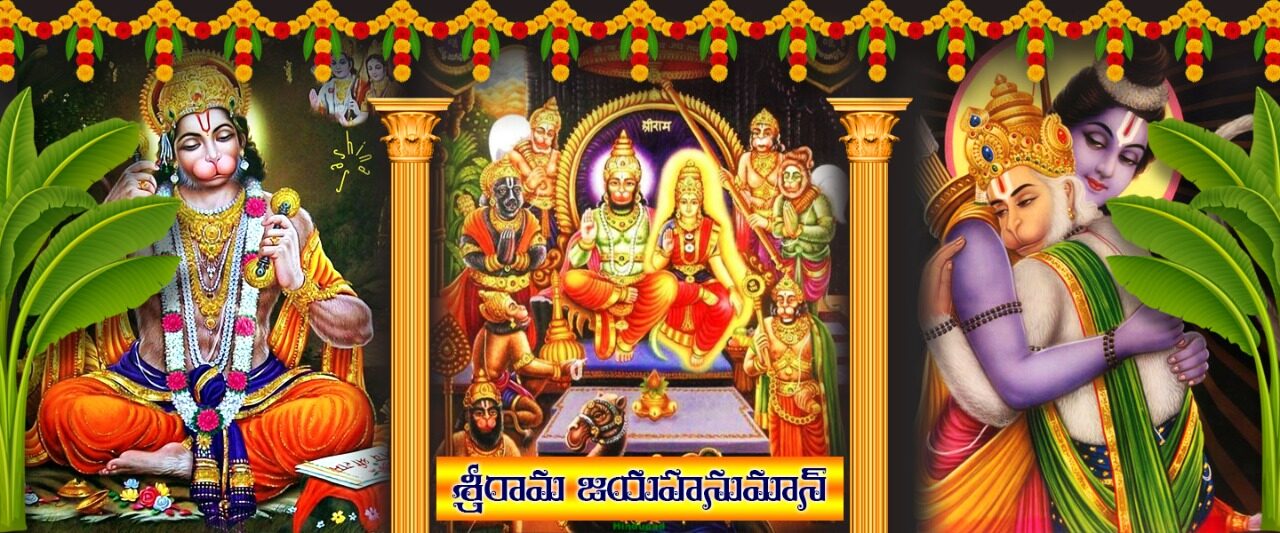
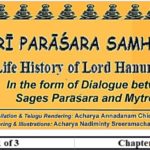
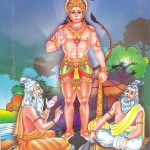


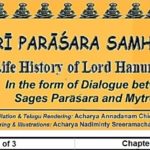
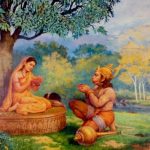
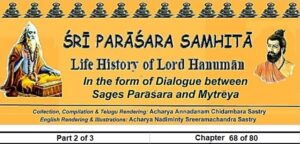
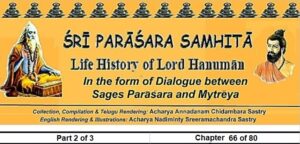
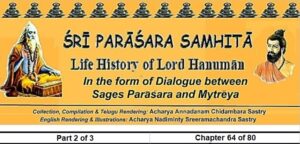
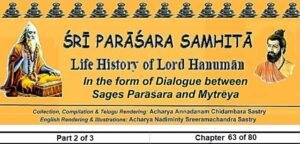
Be First to Comment